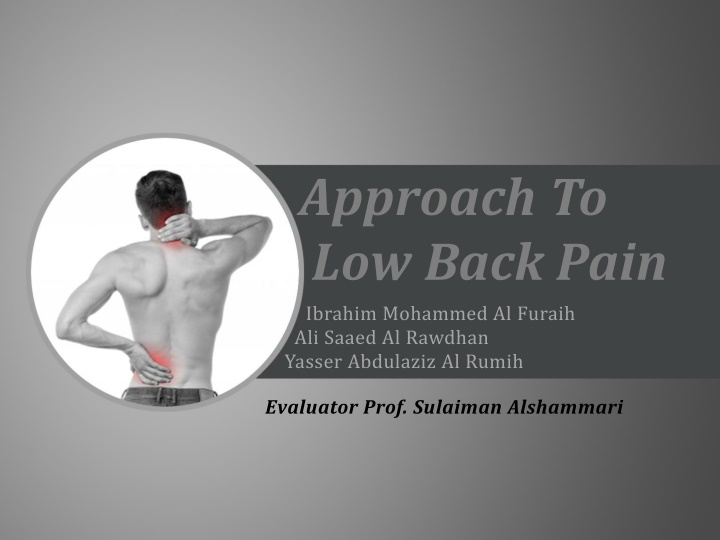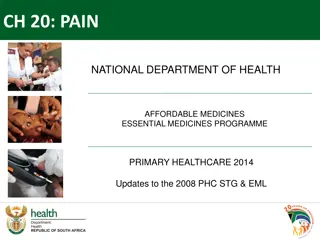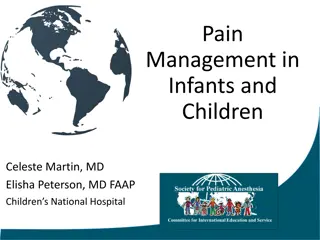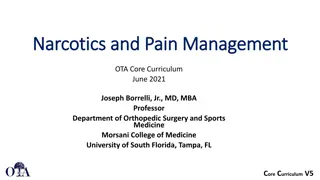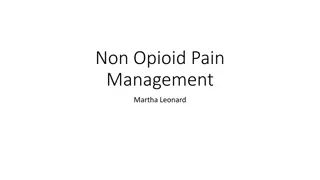Approach to Low Back Pain Evaluation and Management
Low back pain evaluation and management involve understanding common causes, risk factors, diagnostic methods, and appropriate interventions. Red flags, such as history of cancer, are crucial in assessment. Imaging studies like MRI may be necessary based on symptoms. Differentiating between mechanical, inflammatory, and nerve compression etiologies is essential for effective treatment and knowing when to refer to specialists.
Download Presentation

Please find below an Image/Link to download the presentation.
The content on the website is provided AS IS for your information and personal use only. It may not be sold, licensed, or shared on other websites without obtaining consent from the author.If you encounter any issues during the download, it is possible that the publisher has removed the file from their server.
You are allowed to download the files provided on this website for personal or commercial use, subject to the condition that they are used lawfully. All files are the property of their respective owners.
The content on the website is provided AS IS for your information and personal use only. It may not be sold, licensed, or shared on other websites without obtaining consent from the author.
E N D
Presentation Transcript
Approach To Low Back Pain Ibrahim Mohammed Al Furaih Ali Saaed Al Rawdhan Yasser Abdulaziz Al Rumih Evaluator Prof. Sulaiman Alshammari
Objectives Brief introduction. Common causes and risk factors. Diagnosis including history, Red Flags. Practical: How to do examination of Back including lower limbs? Brief comment on Mechanical, Inflammatory, Root nerve compression, Malignancy Role of primary health care in management When to refer to specialist Prevention and Education
Q. 1 A 45 year old man without significant past medical history presents with severe back pain after lifting boxes at work two days ago. Other than his back pain his review of symptoms is negative, the pain radiates from his lower back down his posterior thigh to his great toe, when you perform both a straight leg raise test and a contralateral leg raise are positives. His strength sensation, and reflexes are preserved. Which of the following images studies should be done immediately? A. Plain radiographs B. MRI C. CT scan D. No imaging indicated.
Q. 2 A 41 year old sedentary man presented to you 6 weeks ago with the acute onset of low back pain radiating to the left leg. His neurological examination at the time was normal but he didn t respond to conservative therapy. X-rays are normal. What is the most appropriate next step? A. flexion extension radiographs. B. MRI C. Electromilography D. Bone scan E. Complete blood count and erythrocyte sedementation rate
Q. 3 Which of the following is a red flag sign/symptom of back pain? A. History of cancer. B. Kyphosis. C. Age less than 50. D. Temperature <36.1 C.
Q. 4 Which of the following elements is the most important in evaluating back pain? A. Lumbar x-ray. B. Acupuncture. C. Taking a history. D. Prescribing a medication and waiting for an effect.
Q. 5 A patient came with lower back pain with morning stiffness, exacerbated by rest and relieved by activity. Which of the following etiologies this presentation considered to be? A. Mechanical back pain B. Inflammatory back pain C. Tumor D. Nerve root compression
Introduction Low back pain is one of the most common reasons for visits to physicians in the ambulatory care setting. Low back pain is a common aliment that affects most people at least once in their lives. The total cost related to back pain is estimated to be >$100 billion per year in the United States.1 If approach is not systematic, cost, identification of non-clinically significant lesions and worsening of psychological condition will all be affected.
Epidemiology Two thirds of all adults experience back pain. A study conducted in Al-Qaseem region, and a response was obtained from 5,743 and Back pain was reported by 1,081 (18.8%). 8.8% were men, and 10% were women.2 In United Kingdom, around 2.6 million people seeking advice about back pain from their general practitioner each year.3
Low back pain can be caused by problems with the muscles, ligaments, discs, bones (vertebrae), or nerves. Often back pain is caused by strains or sprains involving the muscles or ligaments. These problems cannot always be seen on imaging tests, such as MRIs or CAT scans.
Risk factors Modifiable: Obesity Smoking Occupational hazards Deformity Previous injury Non-modifiable: Genetics Aging
Classification o Back pain is classified as Acute and Chronic: Acute back pain is usually the result of an injury or a sudden jolt and can last from a few days to a few weeks; it is generally resolved within 6 to 12 weeks. Back pain becomes chronic when it persist for 3 to 6 months beyond the expected healing time. About 15% of low back pain cases progress from acute to chronic.
Acute Subacute Chronic < 6 weeks 6 weeks - 3 months > 3 months
Causes of Back Pain NON- MECHANICAL MECHANICAL Spinal Stenosis Herniated Disc Inflammatory Infections Tumors Psychological Spondylolisthesis Malingering
History During taking history, you must cover the following: The course of pain. Is there evidence of a systemic disease? Is there evidence of neurologic problems? Occupational history. Red flags.
Personal History Age Gender Occupation Chief Complaint Duration Route of Admission Time of Admission
History Of Presenting Illness Site. Onset. Character Radiation. Associated symptoms Constitutional Symptoms and red flags Time Exacerbation & Relieving factors. Severity
Past History Medical Surgical Drugs and Allergies Family Social
Red flags4 Age more than 50 years History of cancer Unexplained weight loss Persistent fever History of intravenous drug use Immunocompromised state Recent bacterial infection Urinary or stool incontinence Urinary retention Extremity weakness Neurologic deficit Trauma
Differentiation Mechanical Back Pain Inflammatory Back Pain Diffuse and unilateral. Deep and dull. Moderate intensity. Relived by Rest. Increased by Activity and at the end of the day. History of previous episodes. Cause: o Injury. o Poorly designed chairs. Chronic Pain. Insidious onset. Throbbing, Aching. Exacerbated by Rest. Relieved by Activity and is worst at morning and end of the day. Morning Stiffness.
Brief comment on Mechanical, Inflammatory, Root nerve com pression and Malignancy
Simple back pain Simple back pain accounts for more the 60% of all causes of back pain. Causes mostly originate from musculoskeletal for example: strained muscle , sprained ligament and h erniated disc etc No signs or symptoms of systemic diseases or presence of red flags. Treatment usually Non-steroidal anti-inflammatory drugs and muscle relaxant.
Scenario A 25-year-old male works as a teacher came to the primary health care clinic complaining of lower back pain for several months. He reports that his symptoms began gradually several months ago. The pain is located in the lower back and buttock area, alternating in two sides, worse in the morning and is associated with stiffness. It gets better throughout the day and with activity. There is a history of fever 1 month ago. He denies radiation or neurological symptoms. No history of malignancy, weight loss, trauma or intravenous drug use.
Examination Position: Standing Exposure: trunk and lower extremities. - Look: no scars, swelling or deformities. Gait: -normal gait. -Normal heal and toe walking - Feel: Mild tenderness over the lumbar and sacroiliac joints - Move: limited and painful active range of motion in all directions. - Special test: Adams Forward bending test is negative.
Examination Position: supine - Look no muscle wasting in the lower limbs. - Feel: negative leg length discrepancy test. - Special test: negative straight leg raising test. Click Here for a demonstrational video
Neurovascular examination Neurological examination 1. Motor: 5/5 2. Sensory: no sensory deficit 3. Tone: normal 4. Reflexes: normal knee and ankle reflexes vascular examination: 1. palpable posterior tibial and dorsalis pedis arteries 2. Normal capillary refill time.
Investigations Plain x-ray of the sacroiliac joint. HLA-B27.
Treatment Nonsteroidal anti-inflammatory drugs has a dramatic response in patient with Ankylosing spondylitis. Referral
Complicated back pain Accounts for 37% of all causes of back pain. Presence of systemic signs, symptoms or risk factor e.g. fever, weight loss, history of prior cancer..etc. Most common causes include: 1. Inflammatory arthritis e.g. ankylosing spondylitis , rheumatoid arthritis. 2. Neoplastic 3. Infection: can cause pain when they involve the vertebrae, leading to osteomyelitis. Plain film and ESR is needed, if either abnormal consider magnetic resonance imaging or computed tomography.
Radiculopathy Lumbosacral radiculopathy is a condition in which a disease process affects the function of one or more lumbosacral nerve roots. Depending upon the nature and location of intraspinal compression, roots may be injured at any disc level, from the L1-2 level to the level of their exit into their neural foramina
Degenerative changes Resulting bony overgrowth (osteophytes) or disc herniation may directly impinge on spinal nerve roots or the spinal cord, or their effect may be primarily to produce instability and misalignment of the spine (ie, degenerative spondylolisthesis) that in turn produces pain and neurologic deficits.
Disc herniation Click Here for a demonstrational video
How to Investigate Disc herniation? Not needed unless there is a presence of red flags, or the patient at a high risk of neoplasia, inflammation or infection.5 If so, magnetic resonance imaging is recommended.
Treatment: The objectives of treatment are to ameliorate pain and to address the specific underlying process if necessary. Nonsteroidal anti-inflammatory drugs or acetaminophen and activity modification are the mainstay of treatment. Physical therapy is often tried for patients with mild to moderate persistent symptoms, but evidence of effectiveness is lacking. Opioids and muscle relaxant to treat acute, severe pain. Surgery is preserved for patients who have persistent, disabling radiculopathy due to a herniated lumbar disc
Urgent situation Bowel or bladder dysfunction may be a symptom of severe compression of the cauda equina, which is a medical emergency. Urinary retention with overflow incontinence is typically present, often with associated saddle anesthesia, bilateral sciatica, and leg weakness. The cauda equina syndrome is most commonly caused by tumor or a massive midline disk herniation. MRI is used to investigate Cauda Equina
Management The management of true cauda equina syndrome frequently involves surgical decompression. When cauda equina syndrome is caused by a herniated disk early surgical decompression is recommended.
Role of primary health care in management
Goals for Treatment Educate patient about the natural history of back pain. Ask about and address the patient s concerns and goals. Maximize functional status. Relief the pain. Improve associated symptoms, such as sleep or mood disturbances or fatigue. Referral of complicated cases. Prevention.
Important to know .. Usually gets better without any treatment. Exercise and surgery are not usually used to treat acute back pain. The majority of episodes are due to a muscular strain which usually resolve with time - because muscles have a good blood supply to bring the necessary nutrients and proteins for healing to take place. -
Approach to the Treatment of Nonspecific Acute Low Back Pain Nonspecific low back pain (LBP) - describes LBP symptoms lacking clear, specific cause. First visit .. Patient education Reassure the patient that the prognosis is often good, with most cases resolving with little intervention. Advise the patient to stay active, avoiding bed rest as much as possible, and to return to normal activities as soon as possible. Advise the patient to avoid twisting and bending.
Initiate trial of a no steroidal anti-inflammatory drug or acetaminophen. Consider a muscle relaxant based on pain severity Because all muscle relaxants have adverse effects, such as drowsiness, dizziness, and nausea, they should be used cautiously
Second visit: Two to four weeks after the initial visit, if the patient has not si gnificantly improved Changing to a different non steroidal anti-inflamm atory drug Referral for physical therapy Referral to a spine subspecialist if pain is seve re or limits function
Management 1. Physical Therapy 2. 2. Application of Ice or Heat 3.Unsupported management: Oral Steroids. Acupuncture. Exercise. Lumbar Support. Massage. Spinal Manipulation and Chiropractic Techniques.
Bed Rest: Bed rest should not be recommended for patients with nonspecific acute low back pain. Prolonged bed rest can also cause adverse effects such as joint stiffness, muscle wasting, an d loss of bone mineral density, pressure ulcers, and venous thromboembolism.
When to refer to specialist? Emergency: referral within hours Urgent: referral within 24 - 48 hours Soon: referral within weeks Depending on the clinical situation, consider communica ting with the specialist consultant to determine the urgency and timelines for referral.
1- Level of low back pain and/or leg pain: o If pain is not alleviated by non-surgical treatments and has continued for a few weeks or months, it may take time to see a spine surgeon. o If the pain is severe, then it may be advisable to consult with a spine specialist sooner.
2- Ability to function with the low back pain: o If one is not able to go to work, drive to the store, and complete other activities of daily livi ng, it may be advisable to consider specialist s ooner rather than later.
